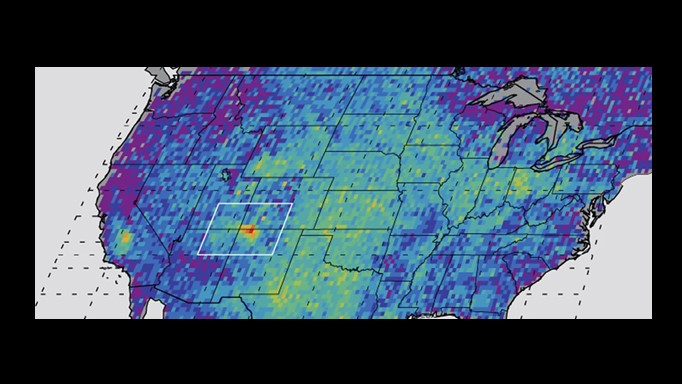David P. Turner / March 30, 2021
Figures updated April 8, 2022
The technosphere is gearing up for a full mobilization against rising greenhouse gas concentrations and associated climate change. The struggle to bring down methane emissions is a key feature of that effort; thus, initiatives by individuals, NGOs, industry, and governments deserve our attention and support. The dangerous trajectory of the atmospheric methane concentration (Figure 1) speaks to the urgency of acting now.

The increasing concentration of methane (CH4) in the atmosphere contributes about 23% to anthropogenic strengthening of the greenhouse effect on Earth. As with carbon dioxide (CO2), the rising concentration of methane in the atmosphere must peak as soon as possible if humanity is to avoid a global environmental change crisis. A significant difference between these two greenhouse gases is that methane has a relatively short atmospheric lifetime (~ 8 years) and hence its concentration will respond rapidly to reductions in emissions.
Scenarios for limiting Earth’s warming to 2oC or less assume that methane emissions will peak soon, followed by a peak and fall off in the methane concentration. However, rather than shrinking, emissions are actually increasing and the rate of annual increase in the methane concentration is growing (Figure 2). The increases in 2020 and 2021 were the highest on record.

The concentration of methane in the atmosphere is the net effect (Figure 3) of sources (emissions) and sinks (consumption). Human driven sources amount to about 60% of total sources. The primary sink of methane is the hydroxyl radical (OH), which is produced in the atmosphere photochemically. The OH molecule has a very short lifetime (~ 1 second) and is difficult to measure. From modeling of atmospheric chemistry and limited OH observations, the oxidation capacity of the atmosphere is considered stable, but there is concern that the increasing methane emissions are extending the atmospheric lifetime of methane and therefore increasing its global warming potential per molecule emitted.

The tripling of methane concentration since around 1800 (Figure 4) is largely attributable to human factors, including expansion of rice agriculture, increase in the number of ruminant livestock, build out of the fossil fuel infrastructure, a rising number of landfills and municipal waste facilities, and more biomass burning associated with agriculture and deforestation.

The upward trend in the growth rate of methane concentration over the last ten years is likewise caused by increasing anthropogenic emissions. Leakage from the fossil fuel infrastructure − some dispersed over regions of intense drilling and mining (Figure 5) and some in the form of massive leaks at particular sites − is one contributor.

Another major factor is the number of ruminant livestock on the planet, which continues to increase in association with growth in the human population and its level of affluence. Deforestation and related biomass burning are also on the rise (2010s > 2000s), notably in Brazil.
Although recent increases in methane emissions are related directly to human factors, Earth system scientists are also concerned about possible increases in emissions from natural methane sources. These include 1) high latitude wetlands and shallow seas where warming temperatures increase rates of decomposition and melting of frozen methane hydrates, and 2) extensive tropical latitude wetlands, where warming temperatures similarly increase rates of decomposition. The potential for pumped up high and low latitude natural sources in response to climate warming is worrisome because it would indicate that a positive (amplifying) feedback to global warming had been engaged. There will be little that humanity can do to disengage that feedback once it gets started.
A lot could be done to reduce current methane emissions of anthropogenic origin, what I refer to as a teleological feedback to climate change.
1) Much of the leakage from the fossil fuel infrastructure could be eliminated if the industry took greater precautions (probably requiring stronger regulations). The Biden clean energy plan includes provisions for reducing methane emissions from the oil and gas sectors of the economy in the United States. An especially exciting development is that the Environmental Defense Fund is working to build an operational satellite-based methane monitoring system, which will report areas of leakage in near real time.
2) The number of ruminant livestock could be reduced by a change in the demand for meat. Contributing factors would be changes in dietary preferences and further development of synthetic meat. Alternative types of cattle feed that reduce methane production are also under investigation.
3) Improved water management in rice fields can bring down methane emissions.
4) Landfills and municipal waste treatment facilities can be designed such that methane from decomposition of organic matter is captured and used for energy production.
Methane emissions in Europe are on the decline because of policy changes in some of these areas.
The prospects for a rapid peak in global methane emissions, followed by a peak in concentration, are linked to success in bringing down CO2 emissions. The potential problem is that if CO2 driven climate change continues in a business-as-usual fashion, it is possible that natural wetland emissions will increase, which would tend to cancel out successes in reducing anthropogenic methane emissions.
Despite quite a bit of uncertainty about past and future trends in the methane budget, Earth system scientists agree that human-driven methane emissions can and should be reduced.


Dang it. That gas well my Dad has been messing with up in Kenai is part of the problem.
We have to release the pressure off the anulis when it gets up to 2,000 psi.
We are in the process to make sure that we don’t continue to do that.
Sorry, we feel bad and guilty.
It sounds like much of the natural gas infrastructure is rather leaky. I just added a related link. Thanks for your comment.
https://www.triplepundit.com/story/2020/methane-leaks-climate-action/707231